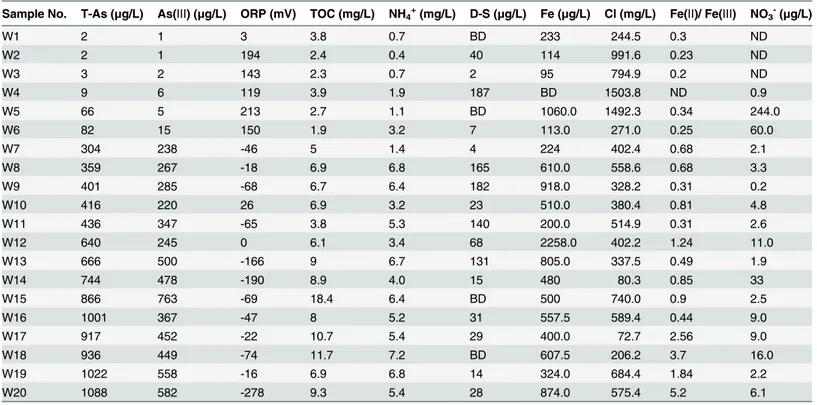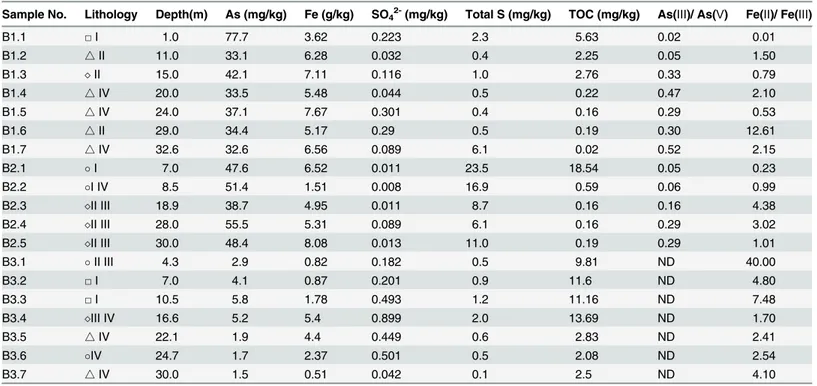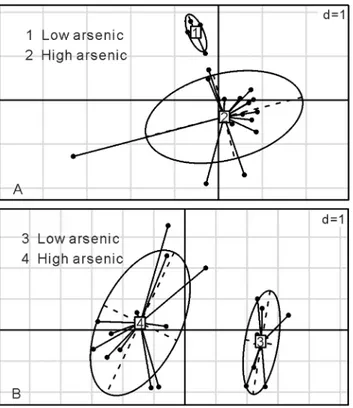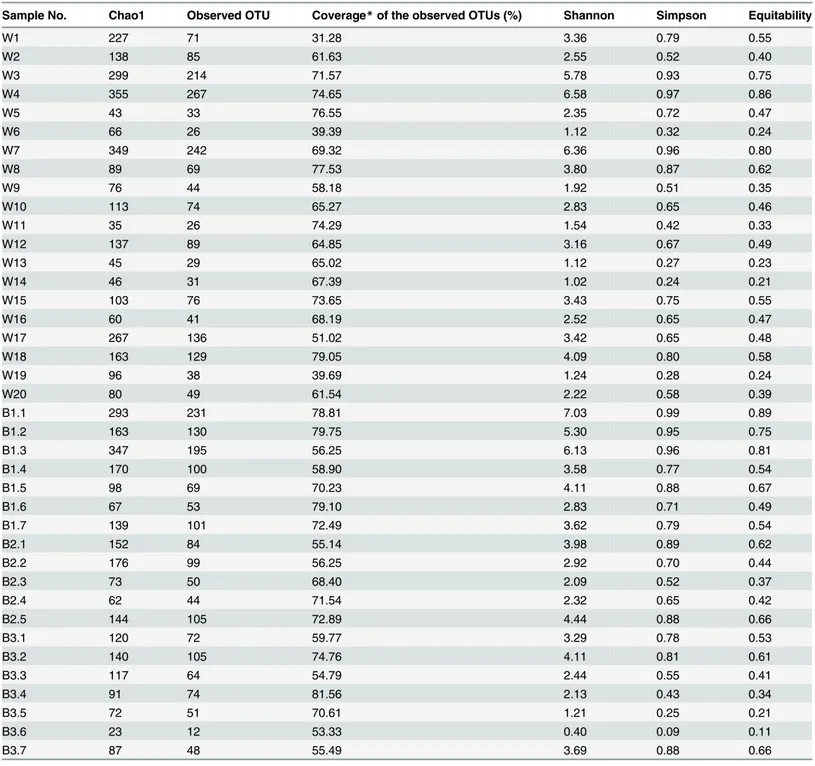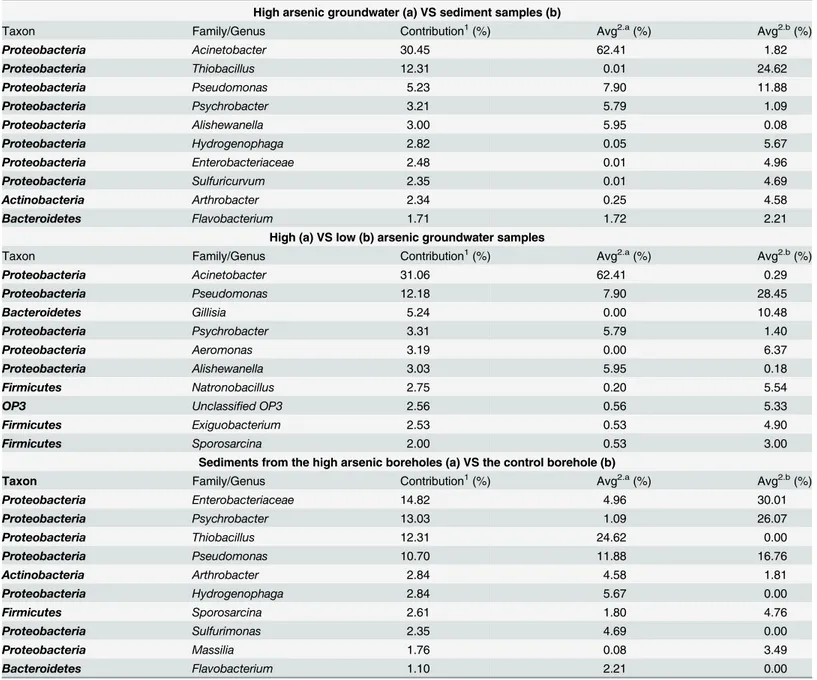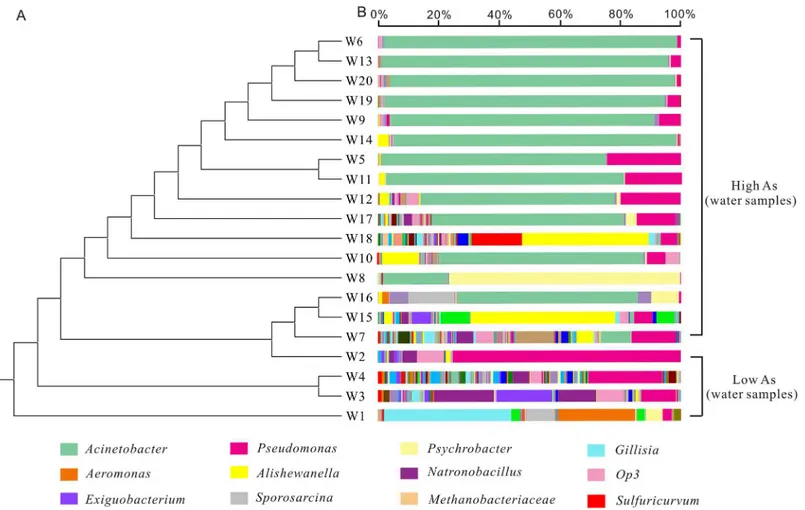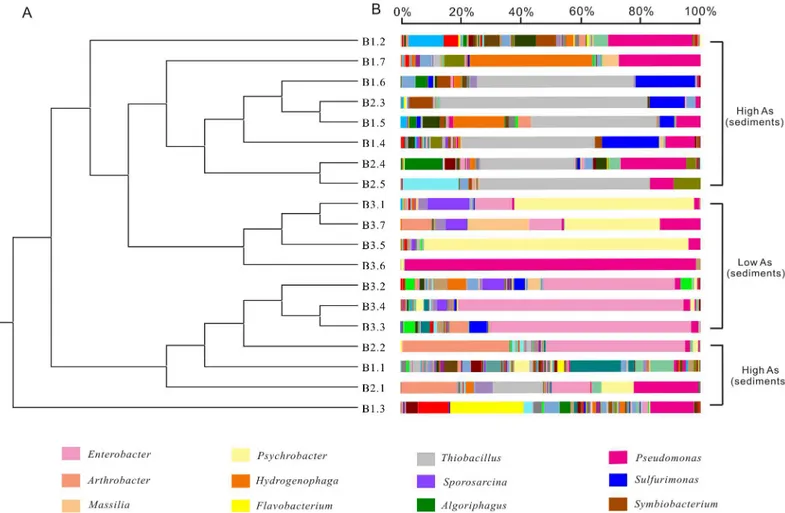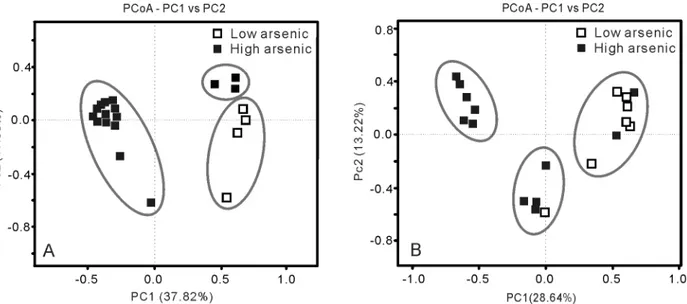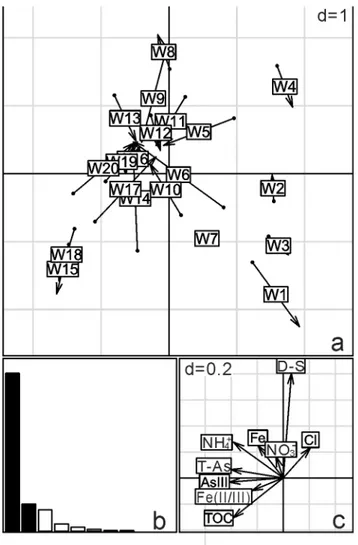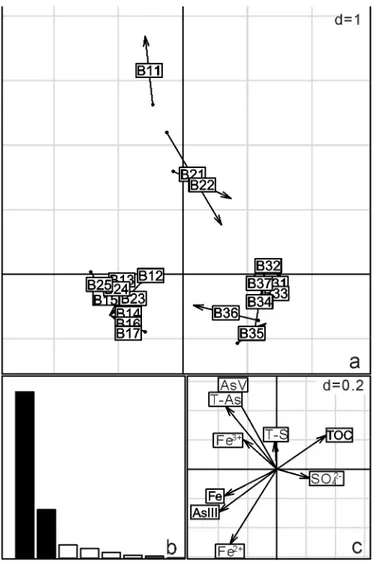Microbial Community in High Arsenic Shallow
Groundwater Aquifers in Hetao Basin of
Inner Mongolia, China
Ping Li1, Yanhong Wang1,2, Xinyue Dai1, Rui Zhang1, Zhou Jiang1,2, Dawei Jiang1, Shang Wang3, Hongchen Jiang1, Yanxin Wang1,2*, Hailiang Dong1,4*
1State Key Laboratory of Biogeology and Environmental Geology, China University of Geosciences, Wuhan, 430074, PRC,2School of Environmental Studies, China University of Geosciences, Wuhan, 430074, PRC,3Institute of Earth Sciences, China University of Geosciences, Beijing, 10083, China,
4Department of Geology and Environmental Earth Science, Miami University, Oxford, OH, 45056, United States of America
*yx.wang@cug.edu.cn(YW); dongh@miamioh.edu(HD)
Abstract
A survey was carried out on the microbial community of 20 groundwater samples (4 low and 16 high arsenic groundwater) and 19 sediments from three boreholes (two high arsenic and one low arsenic boreholes) in a high arsenic groundwater system located in Hetao Basin, Inner Mongolia, using the 454 pyrosequencing approach. A total of 233,704 se-quence reads were obtained and classified into 12–267 operational taxonomic units
(OTUs). Groundwater and sediment samples were divided into low and high arsenic groups based on measured geochemical parameters and microbial communities, by hierarchical clustering and principal coordinates analysis. Richness and diversity of the microbial com-munities in high arsenic sediments are higher than those in high arsenic groundwater. Mi-crobial community structure was significantly different either between low and high arsenic samples or between groundwater and sediments.Acinetobacter,Pseudomonas, Psychro-bacterandAlishewanellawere the top four genera in high arsenic groundwater, while Thio-bacillus,Pseudomonas,Hydrogenophaga,Enterobacteriaceae,Sulfuricurvumand Arthrobacterdominated high arsenic sediments. Archaeal sequences in high arsenic groundwater were mostly related to methanogens. Biota-environment matching and co-in-ertia analyses showed that arsenic, total organic carbon, SO42-, SO42-/total sulfur ratio, and Fe2+were important environmental factors shaping the observed microbial communities. The results of this study expand our current understanding of microbial ecology in high arse-nic groundwater aquifers and emphasize the potential importance of microbes in arsearse-nic transformation in the Hetao Basin, Inner Mongolia.
OPEN ACCESS
Citation:Li P, Wang Y, Dai X, Zhang R, Jiang Z, Jiang D, et al. (2015) Microbial Community in High Arsenic Shallow Groundwater Aquifers in Hetao Basin of Inner Mongolia, China. PLoS ONE 10(5): e0125844. doi:10.1371/journal.pone.0125844
Academic Editor:Hauke Smidt, Wageningen University, NETHERLANDS
Received:October 8, 2014
Accepted:March 26, 2015
Published:May 13, 2015
Copyright:© 2015 Li et al. This is an open access article distributed under the terms of theCreative Commons Attribution License, which permits unrestricted use, distribution, and reproduction in any medium, provided the original author and source are credited.
Data Availability Statement:All relevant data are within the paper and its Supporting Information files.
Introduction
Arsenic contamination in groundwater is a serious environmental issue in many countries such as Bangladesh, West Bengal, India, Burma, Vietnam, and China [1–2]. In China, popula-tions at risk of exposure to excessive levels of arsenic (As) have been emerging since the 1960s [3]. Recent reports showed that about 19.6 million people are at risk of being affected by arse-nic-contaminated groundwater [3–4]. Long time ingestion of arsenic groundwater can result in arsenicosis that causes many kinds of chronic diseases including cardiovascular, renal and re-spiratory diseases, as well as skin, lung, liver, kidney and prostate cancers [5–7].
Hetao Basin of Inner Mongolia is located in the arid-semiarid region in northwestern China and is one of the worst areas affected by arsenic poisoning in China [3,4,8,9]. As concentra-tions in groundwater from this region are generally high, with some being more than 100 times the upper limit (10μg/L) recommended by the World Health Organization [8,10]. Local
resi-dents have been drinking high arsenic groundwater for over 20 years, resulting in more than 300, 000 cases of arsenicosis, seriously threatening public health and impacting sustainable de-velopment of the local economy [9].
Over the last decade, numerous hydrological, mineralogical and geochemical studies have been performed to investigate As mobilization and transformation mechanisms in the Hetao Basin [11–20]. There is a consensus that reductive dissolution of Fe oxide minerals and oxida-tion of pyrite release solid-phase As into groundwater. Previous studies have shown that As mobilization and transformation can be ascribed to complex interactions between microbes and geochemical processes [13,21–22]. Recently, several studies have used traditional molecu-lar methods such as denatured gradient gel electrophoresis (DGGE), terminal restriction frag-ment length polymorphism (TRFLP) and clone library analysis to characterize microbial communities in this basin [23–29]. Although these studies have yielded certain insights into the mechanisms of As mobilization and transformation, a comprehensive picture has not emerged, due to small numbers of samples studied and shallow sequencing depths used with these traditional methods [30]. Microbial communities in groundwater and sediments with contrasting As levels and geochemistry have yet to be fully understood. The important environ-mental factors shaping the microbial community structure are still poorly known. High-throughput sequencing approach, such as 454 pyrosequencing allows us to study a large set of samples across large geochemical gradients and at the same time to achieve a greater sequenc-ing depth to capture rare microbes [31]. This characterization is important because arsenic-transforming microbes may be minor components in the overall community [32,33]. There-fore, it is necessary for us to fill the above knowledge gap by using a high-throughput sequenc-ing method coupled with rigorous statistical analysis.
Consequently, in this study, we used 454 pyrosequencing to: (1) reveal the diversity and structure of microbial communities in groundwater and sediments with different geochemis-try; (2) assess the potential relationships between microbial communities and geochemical conditions, and subsequently (3) evaluate the putative roles of microorganisms in As release and mobilization in arsenic-rich aquifers of the Hetao Basin in Inner Mongolia of China. To achieve these objectives, a coordinated geochemical and molecular survey was conducted on 20 groundwater samples and 19 sediments from three boreholes in Hangjinhouqi County. The re-lationships among microbial diversity, community structure, and geochemistry were explored. The results of this study identify certain microorganisms that may be potentially important in regulating As biogeochemical transformation in the basin and expand our current understand-ing of As geomicrobiology in high As aquifers around the world.
Materials and Methods
Site description
No specific permission was required for the described field studies because no animal or human subjects were involved in this research. The sampling locations are not privately owned or protected in any way. The field studies did not involve endangered or protected species.
The Hetao Plain is located in the western part of Inner Mongolia, China (Fig 1). The plain is formed at the end of Jurassic and contains fine clastic sediments. With the development of the Yellow River, frequent channels have deposited large amounts of sediments and generated oxbow lakes that have accumulated humus- and organic-rich mud. Shallow aquifers, the target of this study, are composed of late Pleistocene and Holocene alluvial and lacustrine deposits. The Hetao Plain has been one of the earliest irrigation districts using diverged Yellow River water. About half of the soils are saline, and soil salinization is further intensified by both strong evapotranspiration and seasonal irrigation. These semi-artesian aquifers are widely used for drinking by local residents in last several decades. Groundwater is recharged by vertical in-filtration of meteoric water, laterally flowing groundwater from bedrocks, and/or by irrigation and leakage from the Yellow River on the south side. Discharge occurs mainly via evapotrans-piration and pumping. Our case study was carried out in Hangjinhouqi County (HC) in the western part of the Hetao Plain where endemic arsenicosis is most serious [34]. Some of the local villagers were affected with serious skin lesions and cancers due to arsenicosis [35–36].
Sample collection and field measurements
All the water samples were collected from drinking-water wells within a depth range of 20–
30 m. High arsenic groundwater samples were collected in villages where arsenicosis is serious (Fig 1andTable 1). Two boreholes (B1 and B2) were drilled at those sites where the groundwa-ter shows the highest arsenic concentration and endemic arsenicosis is extremely serious. For comparison, low arsenic groundwater (W1-4) and sediment samples (B3.1-B3.7 from borehole B3) were collected at the sites with no arsenicosis (Fig 1). In total, twenty groundwater samples and nineteen sediment samples were collected for this study (Fig 1). Of the groundwater sam-ples, three were collected in Taiyangmiao (sample W1, 2 and 17), 2 in Erdaoqiao (sample W3 and 6), 1 in Sizhi (sample W5), 1 in Manhui (sample W4), 10 located in Shahai (sample W7, 8, 9, 11, 12, 14, 15, 16, 18 and 19), 2 in Tuanjie (sampleW10 and 13), and 1 in Shanba (sample W20). Nineteen sediment samples were collected from three boreholes, and of which 7 samples from high As borehole B1 named as B1.1-B1.7(107°00'33.8''E, 40°58'01.0''N), 5 samples from high As borehole B2 named as B2.1-B2.5(107°14002.5@E, 40°58044.8@N), and 7 samples from
low As borehole B3 named as B3.1-B3.7 (106°53050.9@E, 40°5503.2@N) (Fig 1). Sediments were
collected from the three boreholes along different depths (Table 2). The sediments from the three boreholes ranged in texture from clay, silt to fine-medium sand and in color from brown, green, dark grey to totally black (Table 2).
Water samples were pumped, and filtered. The tubing was flushed substantially prior to each use. Samples used for total soluble As, Fe, NH4+and dissolved total sulfide were filtered through 0.45μm mixed cellulose ester membrane filters. The filtrates were acidified to pH<2. To determine total dissolved sulfide, water samples were collected into acid-washed polyethyl-ene bottles, preserved with zinc acetate and sodium hydroxide on-site to stabilize the sulfide. Arsenic speciation separation was accomplished with disposable syringes and silica-based strong anion exchange cartridges (Supelco, USA) at each sampling point following a previous method [27]. Microbial samples were collected by filtration of 5–10 L water through 0.2-μm
conical centrifuge tube. For sediment sampling, boreholes were drilled using a 12-cm diameter piston-coring device to depth of 30 to 33 m, and sediment samples were immediately packed into polyethylene bags and sealed. All groundwater and sediment samples were immediately frozen and stored on dry ice in the field and during transportation (within two days), and then kept at -80°C in laboratory until further analysis.
Geochemistry measurements
Anion and As concentrations were measured according to previously published methods [27, 37]. Briefly, arsenic concentration in water samples was determined by using liquid chromatog-raphy-hydride generation-atomic fluorescence spectrometry (LC-HG-AFS, Haiguang AFS-9780, Beijing). Concentrations of anions, including SO42-, NO3-, Cl-, and F-were determined by ion chromatography (DX-120, Dionex, USA). NH4+was determined by the Nessler’s re-agent colorimetric method [8]. Total dissolved sulfide concentration was determined from precipitated zinc sulfide using the methylene blue method [8]. Total and ferrous iron concen-trations were determined with the 1,10-phenanthroline-based assay [38]. Methane in water samples was analyzed with MAT-271 mass spectrometer at the Lanzhou Institute of Geology, Fig 1. Map showing the location of the study area and the sampling sites.Numbers 1–20 refer to
groundwater samples W1-20. Numbers B1-3 refer to three sampling boreholes.
doi:10.1371/journal.pone.0125844.g001
Table 1. Geochemical parameters and major ion concentrations of groundwater samples.
Sample No. T-As (μg/L) As(Ⅲ) (μg/L) ORP (mV) TOC (mg/L) NH4+(mg/L) D-S (μg/L) Fe (μg/L) Cl (mg/L) Fe(Ⅱ)/ Fe(Ⅲ) NO3-(μg/L)
W1 2 1 3 3.8 0.7 BD 233 244.5 0.3 ND
W2 2 1 194 2.4 0.4 40 114 991.6 0.23 ND
W3 3 2 143 2.3 0.7 2 95 794.9 0.2 ND
W4 9 6 119 3.9 1.9 187 BD 1503.8 ND 0.9
W5 66 5 213 2.7 1.1 BD 1060.0 1492.3 0.34 244.0
W6 82 15 150 1.9 3.2 7 113.0 271.0 0.25 60.0
W7 304 238 -46 5 1.4 4 224 402.4 0.68 2.1
W8 359 267 -18 6.9 6.8 165 610.0 558.6 0.68 3.3
W9 401 285 -68 6.7 6.4 182 918.0 328.2 0.31 0.2
W10 416 220 26 6.9 3.2 23 510.0 380.4 0.81 4.8
W11 436 347 -65 3.8 5.3 140 200.0 514.9 0.31 2.6
W12 640 245 0 6.1 3.4 68 2258.0 402.2 1.24 11.0
W13 666 500 -166 9 6.7 131 805.0 337.5 0.49 1.9
W14 744 478 -190 8.9 4.0 15 480 80.3 0.85 33
W15 866 763 -69 18.4 6.4 BD 500 740.0 0.9 2.5
W16 1001 367 -47 8 5.2 31 557.5 589.4 0.44 9.0
W17 917 452 -22 10.7 5.4 29 400.0 72.7 2.56 9.0
W18 936 449 -74 11.7 7.2 BD 607.5 206.2 3.7 16.0
W19 1022 558 -16 6.9 6.8 14 324.0 684.4 1.84 2.2
W20 1088 582 -278 9.3 5.4 28 874.0 575.4 5.2 6.1
T-As: Total arsenic D-S: Dissolved sulfide BD: below detection limit ND: not determined
Chinese Academy of Sciences. Total organic carbon (TOC) was measured using a TOC analyz-er (TOC-VCPH, Shimadzu Corporation, Japan).
As speciation, SO42-and total sulfur (T-S), total and ferrous iron concentrations, and TOC content in sediment samples were measured according to previously published methods [39–
41]. Before extraction, external layers of sediment cores were removed and each sediment sam-ple was homogenized in an anaerobic chamber filled with 95% N2and 5% H2(Coy Laboratory Products, Grass Lake, MI, USA). Arsenic was extracted from 0.2 g of each sediment sample with orthophosphoric acid and ascorbic acid. The mixture was maintained in microwave (MARSXpress, CEM Corp., USA) at 60 W for 10 min [40,41]. For total sulfur concentration measurement, sediment samples of 1 gram in weight were digested with a microwave digestion technique in a HNO3-HF-H3BO3solution and heated at 100–110°C for 40 min. Sulfate was ex-tracted using 0.01 M Ca(H2PO4)2(pH = 4.0) as extractant [42]. Total and ferrous iron was ex-tracted from 0.1 g sediment samples with 1.8 M H2SO4and 48% HF and determined with the 1,10-phenanthroline assay [43]. TOC contents of sediment samples were measured using a TOC analyzer (Vario MICRO cube, Elementar, Hanau, Germany). All samples were run in triplicate and then averaged.
DNA extraction and amplification of 16S rRNA genes
Before DNA extraction, external layers of sediment cores were removed to avoid possible con-tamination. DNA extractions for all groundwater and sediments samples were conducted using the FastDNA spin kit for soil (MP Bio, USA) according to manufacturer's manual. DNA yield was quantified with Nanodrop (Thermo Scientific NanoDrop 2000), and then stored at Table 2. Geochemical parameters and major ion concentrations of sediments from two high arsenic boreholes and one control borehole.
Sample No. Lithology Depth(m) As (mg/kg) Fe (g/kg) SO42-(mg/kg) Total S (mg/kg) TOC (mg/kg) As(Ⅲ)/ As(Ⅴ) Fe(Ⅱ)/ Fe(Ⅲ)
B1.1 □I 1.0 77.7 3.62 0.223 2.3 5.63 0.02 0.01
B1.2 4II 11.0 33.1 6.28 0.032 0.4 2.25 0.05 1.50
B1.3 II 15.0 42.1 7.11 0.116 1.0 2.76 0.33 0.79
B1.4 4IV 20.0 33.5 5.48 0.044 0.5 0.22 0.47 2.10
B1.5 4IV 24.0 37.1 7.67 0.301 0.4 0.16 0.29 0.53
B1.6 4II 29.0 34.4 5.17 0.29 0.5 0.19 0.30 12.61
B1.7 4IV 32.6 32.6 6.56 0.089 6.1 0.02 0.52 2.15
B2.1 I 7.0 47.6 6.52 0.011 23.5 18.54 0.05 0.23
B2.2 I IV 8.5 51.4 1.51 0.008 16.9 0.59 0.06 0.99
B2.3 II III 18.9 38.7 4.95 0.011 8.7 0.16 0.16 4.38
B2.4 II III 28.0 55.5 5.31 0.089 6.1 0.16 0.29 3.02
B2.5 II III 30.0 48.4 8.08 0.013 11.0 0.19 0.29 1.01
B3.1 II III 4.3 2.9 0.82 0.182 0.5 9.81 ND 40.00
B3.2 □I 7.0 4.1 0.87 0.201 0.9 11.6 ND 4.80
B3.3 □I 10.5 5.8 1.78 0.493 1.2 11.16 ND 7.48
B3.4 III IV 16.6 5.2 5.4 0.899 2.0 13.69 ND 1.70
B3.5 4IV 22.1 1.9 4.4 0.449 0.6 2.83 ND 2.41
B3.6 IV 24.7 1.7 2.37 0.501 0.5 2.08 ND 2.54
B3.7 4IV 30.0 1.5 0.51 0.042 0.1 2.5 ND 4.10
I: brown, II: green; III: dark grey, IV: black
□clay,silty clay,medium sand,4fine sand ND: not determined
-80°C until PCR amplification. The bacterial and archaeal V4-V8 variable regions of the 16S rRNA gene were amplified with the modified forward primer 515F (5’-GTGCCAGCMGCC GCGGTAA-3’) in combination with the reverse primer 1391R (5’-GACGGGCGGTGWG TRCA-3’). Unique 8-bpbarcodes were added at the 5’-end of both the forward and reverse primers to identify the samples from the reads [44]. PCR was carried out under aseptic condi-tions using autoclaved and/or UV-treated plastic ware and pipettes. All PCRs were undertaken in Master cycler ep Gradient S Thermal Cycler block (Eppendorf, Hamburg, Germanny). A typical 50μL PCR mixtures contained 0.4 pmol m/L of primers (MWG), 1μL DNA template
(20–50 ng), 10x reaction buffer (Promega Corporation), 5 mM MgCl2, 1.5 U Biotaq DNA poly-merase (Promega), 0.25 m dNTP (Promega). PCRs were performed with the following thermo cycler program: denaturation at 95°C for 5 min, 30 cycles of denaturation at 94°C for 1 min, annealing at 55°C for 45 seconds and extension at 72°C for 1 min; and final extension at 72°C for 7 min [27].
Pyrosequencing and data analysis
Pyrosequencing of the V4 region of the 16S rRNA gene was carried out from the 515F-end of the amplicons with the Roche (454) genome sequencer FLX+ system (454 Life Sciences, USA) at SeqWright Inc (Houston, USA). All data analyses were performed using the Quantitative in-sights into microbial ecology (QIIME) software package, version 1.5.0 (http://qiime.org/install/ virtual_box.html#virtual-box) [45]. Low quality reads were filtered out using split_libraries.py, and then the remaining reads were denoised to reduce the amount of erroneous operational taxonomic units (OTUs). Chimeric sequences were identified with Chimera Slayer and exclud-ed. The uclust method was used for OTU picking [46]. The most abundant sequence in each cluster was chosen as a representative. All representative sequences were aligned with Python nearest alignment space termination (PyNAST)[47]. Sequences were clustered against the Greengenes database (http://greengenes.lbl.Gov) at 97% identity using uclust [46]. The pyrose-quencing reads were deposited at the European Molecular Biology Laboratory-European Bio-informatics Institute (EMBL-EBI) database under the accession number ERR699330.
Statistical analysis of geochemical and microbial data
important geochemical parameters that contributed to the observed difference of microbial community structure. Environmental variables were identified based on significance calculated from canonical correspondence analysis and variance inflation factors (VIFs) results before biota-environment matching analysis (BIO-ENV). The BIO-ENV procedure and co-inertia analysis (CIA, ad4 package) [51] were used to detect the relationships between microbial com-munity composition and environment factors.
Results
Sample characteristics and geochemical composition
Ten environmental variables that were correlated with microbial communities of groundwater were selected on the basis of correlation identification (Table 1). PCoA and hierarchical clus-tering analyses divided the geochemistry of the 20 groundwater samples into two groups (Fig 2AandS1 Fig). The first group consisted of four samples (W1-4), which were characterized by a low arsenic content (<10μg/L), relatively high oxidation reduction potential (ORP, mean value 115 mV), and low TOC and NH4+. The concentrations of CH4in these samples were all below detection limit (1 ppmv). The second group included two sub-groups: an intermediate arsenic concentration group (W7-13, 304–666μg/L total As), and a high arsenic concentration
group (W14-20, 744–1088μg/L As). Most samples in the second group were either neutral or
slightly alkaline in pH. The ORP of these samples were negative with the medium and mean Fig 2. PCoA plots based on different arsenic concentrations.Each of the groups is numbered inside square boxes. The 20 groundwater and 19 sediment samples are indicated and linked to the boxes, respectively. The ellipses represent group clusters based on K-means clustering. The scale is given by the value in the upper right corner which represents the length of the side of background grid squares. A: groundwater samples; B: sediment samples. Group 1: arsenic concentrations between 2–9μg/L in low
arsenic groundwater; group 2: arsenic concentrations between 66–1088μg/L in high arsenic groundwater;
group 3: arsenic concentrations between 1.5–5.8 mg/kg in sediments from the control borehole B3; group 4:
arsenic concentrations between 33.1–77.7 mg/kg in sediments from high arsenic borehole B1 and B2.
values of -47.0 mV and -51.65 mV, respectively. Some samples in this group had high sulfide concentrations. Arsenic concentrations were generally high in the samples that had low con-centrations of sulfate, negative ORP, high concon-centrations of As(III), high ratios of Fe(II) to Fe (III), and high TOC content. Such geochemical characteristics indicated that a strong reducing condition prevailed in the high arsenic groundwater samples.
Eight environmental variables were identified to be correlated with microbial communities in the sediments (Table 2). PCoA (Fig 2B) and hierarchical clustering (S1andS2Figs) analyses geochemically divided all the sediment samples into two well-defined groups: a high arsenic group (including samples B1.1-B1.7 and B2.1-B2.5) and a control group (samples B3.1-B3.7 from the control borehole). The total arsenic (T-As) concentrations in the sediments from the two high arsenic boreholes ranged from 33.1 to 77.7 mg/kg. The As(III) concentrations and As (III)/total As ratios increased with depth. In contrast, As(V) generally decreased with depth. Total Fe concentrations and the ratios of Fe(II) to Fe(III) ranged from 1.51–8.08 g/kg and 0.01 to 12.61, respectively, and showed an overall increasing trend with depth in high arsenic sam-ples. SO42-concentrations and total sulfur varied between 8–301 mg/kg and 0.4–23.5 g/kg, re-spectively. For the sediments from control borehole B3, total arsenic concentrations were distinctly lower than those in the two high As boreholes B1 and B2, with a range from 1.5 to 5.8 g/kg. Total sulfur and total Fe (T-Fe) concentrations in these sediments from the control borehole were relatively lower with mean values of 2.31 g/kg and 0.83 mg/kg, respectively, but the ratios of sulfate to total sulfur (mean value 0.52) were distinctly higher than those in high arsenic sediments (mean value 0.14).
Alpha diversity of microbial community
A total of 233,704 reads were obtained for the 39 groundwater and sediment samples after re-moval of low-quality and chimeric sequences. A variety of taxa were observed at the 97% OTU level, with 12–267 observed and 23–355 predicted OTUs (based on Chao1). Coverage values ranged from 31.3% to 81.6% (Table 3). For the groundwater samples, the average species rich-ness (Chao1), Shannon diversity, and equitability for the high arsenic group were lower than those for the low arsenic group. Mantel tests failed to identify correlations between these diver-sity indices and T-As, As(III), and any other measured geochemical variables in the groundwa-ter samples. However, the diversity indices for the sediment communities were moderately correlated with SO42-concentration and the ratio of SO42-to T-S (SO42-and Simpson: r = 0.44, p = 0.03; SO42-and equitability: r = 0.35, p = 0.007; SO42-/T-S and Shannon: r = 0.24,
p = 0.047; SO42-/T-S and Simpson: r = 0.50, p = 0.001).
Microbial community composition
(62.41%), whereasThiobacilluswas the most abundant (average abundance 24.62%) in the sed-iments but absent in most groundwater samples (average abundance 0.01%).
There were large differences in the microbial community structures between the low and high arsenic samples. The predominant groups in high arsenic groundwater were Acinetobac-ter,PsychrobacterandAlishewanella. Two genera includingGillisiaandAeromonaswere only Table 3. Alpha diversity indices at the 97% OTU level of groundwater and sediment samples with sequence number higher than 1248.
Sample No. Chao1 Observed OTU Coverage*of the observed OTUs (%) Shannon Simpson Equitability
W1 227 71 31.28 3.36 0.79 0.55
W2 138 85 61.63 2.55 0.52 0.40
W3 299 214 71.57 5.78 0.93 0.75
W4 355 267 74.65 6.58 0.97 0.86
W5 43 33 76.55 2.35 0.72 0.47
W6 66 26 39.39 1.12 0.32 0.24
W7 349 242 69.32 6.36 0.96 0.80
W8 89 69 77.53 3.80 0.87 0.62
W9 76 44 58.18 1.92 0.51 0.35
W10 113 74 65.27 2.83 0.65 0.46
W11 35 26 74.29 1.54 0.42 0.33
W12 137 89 64.85 3.16 0.67 0.49
W13 45 29 65.02 1.12 0.27 0.23
W14 46 31 67.39 1.02 0.24 0.21
W15 103 76 73.65 3.43 0.75 0.55
W16 60 41 68.19 2.52 0.65 0.47
W17 267 136 51.02 3.42 0.65 0.48
W18 163 129 79.05 4.09 0.80 0.58
W19 96 38 39.69 1.24 0.28 0.24
W20 80 49 61.54 2.22 0.58 0.39
B1.1 293 231 78.81 7.03 0.99 0.89
B1.2 163 130 79.75 5.30 0.95 0.75
B1.3 347 195 56.25 6.13 0.96 0.81
B1.4 170 100 58.90 3.58 0.77 0.54
B1.5 98 69 70.23 4.11 0.88 0.67
B1.6 67 53 79.10 2.83 0.71 0.49
B1.7 139 101 72.49 3.62 0.79 0.54
B2.1 152 84 55.14 3.98 0.89 0.62
B2.2 176 99 56.25 2.92 0.70 0.44
B2.3 73 50 68.40 2.09 0.52 0.37
B2.4 62 44 71.54 2.32 0.65 0.42
B2.5 144 105 72.89 4.44 0.88 0.66
B3.1 120 72 59.77 3.29 0.78 0.53
B3.2 140 105 74.76 4.11 0.81 0.61
B3.3 117 64 54.79 2.44 0.55 0.41
B3.4 91 74 81.56 2.13 0.43 0.34
B3.5 72 51 70.61 1.21 0.25 0.21
B3.6 23 12 53.33 0.40 0.09 0.11
B3.7 87 48 55.49 3.69 0.88 0.66
*Coverage is the ratio of the observed OTUs to Chao1.
present in low arsenic groundwater. Other genera includingNatronobacillus,Unclassified OP3, Exiguobacterium, andSporosarcinawere much more abundant in low arsenic groundwater than in high arsenic groundwater. For the sediments,Thiobacillus,Hydrogenophaga, Sulfuri-monasandFlavobacteriumwere present only in the high arsenic sediments, but Enterobacter-iaceae,Psychrobacter,Pseudomonas,SporosarcinaandMassiliawere much more predominant in the control sediments. Some microbial groups were highly abundant in certain samples. For example,Hydrogenophagawas predominant in samples D1.5 and D1.7. The percentages of Table 4. Top ten taxonomic groups identified by SIMPER (at the 97% level) that contributed to dissimilarity among different sample groups.
High arsenic groundwater (a) VS sediment samples (b)
Taxon Family/Genus Contribution1(%) Avg2.a(%) Avg2.b(%)
Proteobacteria Acinetobacter 30.45 62.41 1.82
Proteobacteria Thiobacillus 12.31 0.01 24.62
Proteobacteria Pseudomonas 5.23 7.90 11.88
Proteobacteria Psychrobacter 3.21 5.79 1.09
Proteobacteria Alishewanella 3.00 5.95 0.08
Proteobacteria Hydrogenophaga 2.82 0.05 5.67
Proteobacteria Enterobacteriaceae 2.48 0.01 4.96
Proteobacteria Sulfuricurvum 2.35 0.01 4.69
Actinobacteria Arthrobacter 2.34 0.25 4.58
Bacteroidetes Flavobacterium 1.71 1.72 2.21
High (a) VS low (b) arsenic groundwater samples
Taxon Family/Genus Contribution1(%) Avg2.a(%) Avg2.b(%)
Proteobacteria Acinetobacter 31.06 62.41 0.29
Proteobacteria Pseudomonas 12.18 7.90 28.45
Bacteroidetes Gillisia 5.24 0.00 10.48
Proteobacteria Psychrobacter 3.31 5.79 1.40
Proteobacteria Aeromonas 3.19 0.00 6.37
Proteobacteria Alishewanella 3.03 5.95 0.18
Firmicutes Natronobacillus 2.75 0.20 5.54
OP3 Unclassified OP3 2.56 0.56 5.33
Firmicutes Exiguobacterium 2.53 0.53 4.90
Firmicutes Sporosarcina 2.00 0.53 3.00
Sediments from the high arsenic boreholes (a) VS the control borehole (b)
Taxon Family/Genus Contribution1(%) Avg2.a(%) Avg2.b(%)
Proteobacteria Enterobacteriaceae 14.82 4.96 30.01
Proteobacteria Psychrobacter 13.03 1.09 26.07
Proteobacteria Thiobacillus 12.31 24.62 0.00
Proteobacteria Pseudomonas 10.70 11.88 16.76
Actinobacteria Arthrobacter 2.84 4.58 1.81
Proteobacteria Hydrogenophaga 2.84 5.67 0.00
Firmicutes Sporosarcina 2.61 1.80 4.76
Proteobacteria Sulfurimonas 2.35 4.69 0.00
Proteobacteria Massilia 1.76 0.08 3.49
Bacteroidetes Flavobacterium 1.10 2.21 0.00
1Contribution of each OTU to the overall dissimilarity between these two clusters (a and b). 2Average abundance of each OTU in these two clusters (a and b).
Arthrobacterin sample B2.1 and B2.2 were significantly higher than in other sediment samples.
The archaeal abundances in high arsenic groundwater and sediment samples were mostly lower than 1%. Methanogens were the predominant archaea in most high arsenic groundwater. Five groundwater samples (W7, 12, 15, 17 and 18) contained>24.4% methanogens out of total archaea.
Overall microbial community structure in relation to geochemistry
The results of pairwise comparisons using ANOSIM suggested that there were significant dif-ferences in the microbial community structure among the identified four groups: 1) between the low and high arsenic groundwater samples; 2) between the high arsenic and low arsenic sediments; 3) between the high arsenic groundwater samples and sediments, with the R-statis-tic values of 0.709, 0.429 and 0.64, respectively and all p values<0.01 in these three compari-sons. Similar result was also identified based on Bray-Curtis dissimilarity at the 97% similarity OTU level using UPGMA or hierarchical cluster trees (Figs3,4andS3 Fig). For example, the low and high arsenic groundwater samples formed two distinct groups. For the sediments, the grouping pattern identified by UPGMA was also similar to that by ANOSIM (Fig 4). PCoA plots of beta diversity results showed that the microbial communities of both groundwater Fig 3. Microbial community compositions of groundwater samples grouped by arsenic concentrations.A. UPGMA cluster tree based on Bray-Curtis dissimilarity at the 97% similarity OTU level; B. microbial compositions at the genus or family level. The legend showed the top twelve OTUs (at the 97% level).
samples and sediments were divided into two distinctly different groups based on As concen-trations (Fig 5).
The BIO-ENV results confirmed that the community structure of the groundwater samples was correlated with concentrations of total As, As(III), TOC and NH4+(r = 0.36). For the sedi-ments, the community structure was moderately correlated with a combination of T-As, As (III)/As(V), SO42-/T-S and Fe2+concentration (r = 0.44). In order to visualize the relative im-portance of geochemical vectors that affected sample ordination, co-inertia analysis was carried out between microbial community and geochemistry (Figs6and7). The length and direction of a geochemical vector represent the degree of influence of that vector on the microbial com-munity structure. The first two axes of the co-inertia analysis explained 83% and 80% of the total environmental variability in the groundwater and sediment samples, respectively. Co-inertia analysis showed the relationships between microbial community composition and envi-ronment factors were marginally significant and significant for 20 groundwater and 19 sedi-ment samples, respectively (groundwater: p = 0.07, r = 0.351; p = 0.002, r = 0.507). Similar to the results of BIO-ENV, CIA showed that microbial communities in high arsenic groundwater were associated with T-As, As(III), TOC and NH4+, and microbial communities in high arsenic sediments were associated with T-As, As(III), T-Fe and Fe2+.
Fig 4. Microbial community compositions of sediment samples grouped by arsenic concentrations.A: UPGMA cluster tree based on Bray-Curtis dissimilarity at the 97% similarity OTU level; B: microbial compositions at the genus or family level. The legend showed the top twelve OTUs (at the 97% level).
Discussion
Important environmental factors shaping the microbial community
structure
Arsenic is one of the key environmental factors that contribute to the difference in the geo-chemistry and microbial community structure in both groundwater and sediments. Ground-water and sediment samples could be divided into well-defined high and low arsenic groups based on both geochemistry and microbial community structure. Previous research has shown that high arsenic aquifers were characterized by high concentrations of total dissolved Fe, NH4+and S2−, high TOC content, low concentrations of NO3−and SO42−, which are different
from low arsenic aquifers [9,6]. Our results are consistent with these previous studies. This geochemical difference could be explained by the mechanisms of arsenic release and mobiliza-tion. Reductive dissolution of As bearing Fe-oxides, hydroxides, and oxyhydroxides and sulfate may release Fe(II), As(V) and sulfide into aqueous solution, which may result in the geochemi-cal characteristics of high arsenic aquifers [12,16,21]. High arsenic in groundwater and sedi-ments may challenge certain microbial populations [23,24] and favor As-resistant ones. This might be the reason that microbial populations in high arsenic samples were distinctly different from those in low arsenic samples.
The dominant microbial community populations were also distinctly different between the high arsenic groundwater and sediment samples (Table 4). Such difference in dominant micro-bial community might be related to difference in the geochemical conditions. Most of the high arsenic groundwater samples were under a strong reducing condition as evidenced by negative ORP, high concentrations of Fe(II), As(III), H2S, CH4, and low concentrations of SO42-. In con-trast, high arsenic sediments were under a weakly reducing condition, as evidenced by low ra-tios of As(III)/As(V) and high rara-tios of SO42-/total sulfur in most samples. The contrasting redox condition between groundwater and sediment, even at the same depth, may be due to redox disequilibrium between them. It is faster for flowing groundwater to each redox equilib-rium than low-permeability sediment rich in clays and silt (Table 2). These differences in the Fig 5. PCoA plots based on microbial communities of 20 groundwater (A) and 19 sediment samples (B).The first two factors P1 and P2 for the groundwater samples can explain 37.82% and 11.95% variations. P1 and P2 for the sediment samples can explain 28.64% and 13.62% variations. Solid and hollow squares indicate high and low As groundwater/sediment samples, respectively.
redox condition and geochemistry were mostly consistent with the observed differences in the dominant microbial community populations between high arsenic groundwater and sediment samples. For examples,Acinetobacter,PsychrobacterandAlishewanellathat were previously identified to be capable of reduction [25,52–54] were predominantly found in our strongly re-ducing groundwater samples. Oxidizing bacteriaThiobacillus,Hydrogenophagaand Sulfuricur-vum[55–57] dominated the sediment samples.
Predominant populations in high arsenic aquifers in Hetao Basin
The predominant groups detected using the 454 pyrosequencing approach in this study were consistent with previous results derived from traditional sequencing methods [27–29]. Howev-er, the relative abundances of the dominant populations were different. The bacterial
Fig 6. Co-inertia (CIA) analysis of the relationships between microbial community composition and environment factors for 20 groundwater samples.The scale is given by the value in the upper right corner which represents the length of the side of background grid squares. (a) Samples projected on the first two axes of the analysis. These axes account for 68% and 16% of the variation, respectively. (b) Histogram of the eigenvalues corresponding to the two co-inertia axes, which are equal to 2.15 and 0.35. (c) Main
geochemical vectors that affect sample ordination in the CIA. The lengths of the vector arrows represent the influence of the given geochemical parameters on the co-structure of the CIA. Main geochemical vectors are represented by their chemical symbols, total arsenic is given as T-As and dissolved sulfide is given as D-S. p-value = 0.07.
communities identified in this study were more abundant and diverse than those detected in previous studies using traditional sequencing methods. For example,Alishewanella, Sulfuricur-vum,Arthrobacter,SporosarcinaandAlgoriphaguswere not detected previously, but they were identified in the current pyrosequencing dataset. The identification of these genera is likely due to the greater sequence depth of the pyrosequencing method, but also the effects of primer sets and PCR bias can not be ruled out either [58].
A few previous studies have investigated microbial communities in high arsenic aquifers, mostly in Bangladesh [23,24], Datong Basin in China [25], Red River Delta, Vietnam, and West Bengal [26,27] with traditional culture-dependent and culture-independent methods such as DGGE, TRFLP and clone library analysis. To our best knowledge, this is the first study to investigate microbial community in high arsenic aquifers across several important
Fig 7. Co-inertia analysis (CIA) of the relationships between 19 sediment samples microbial community composition and environment factors.The scale is given by the value in the upper right corner which represents the length of the side of background grid squares. (a) Samples projected on the first two axes of the analysis. These axes account for 55% and 26% of the variation, respectively. (b) Histogram of the eigenvalues corresponding to the two co-inertia axes, which are equal to 3.15 and 0.85. (c) Main geochemical vectors that affect sample ordination in the co-inertia. The lengths of the vector arrows represent the influence of the given geochemical parameters on the co-structure of the CIA. Main geochemical vectors are represented by their chemical symbols, total arsenic is given as T-As and total sulfur is given as T-S. p-value = 0.002.
geochemical gradients with high throughput sequencing approach. In high arsenic groundwa-ter samples, the dominant groups in our study area were different from those in high arsenic tube wells in Bangladesh (such asAcidovorax,Acinetobacter,Hydrogenophaga[23], Pseudomo-nas,ElizabethkingiaandPantoea[24]). These differences may be related to different geochemi-cal conditions such as ORP [24]. In contrast, high arsenic sediment communities in our study site,Thiobacillus,HydrogenophagaandArthrobacterare similar to those in high arsenic sedi-ments from Red River Delta and West Bengal [26,59]. Likewise, some genera such as Pseudo-monas,AcinetobacterandArthrobacterhave been found in the high arsenic aquifers in Shanyin County, Datong Basin, China [25].
Potential roles of microorganisms in As release and mobilization
Based on sequence similarity to cultured representatives, we speculate that abundant processes in our high arsenic samples appeared to be related to arsenic resistance, arsenate reduction, sul-fur oxidation, hydrogen oxidation, and denitrification. For example,Acinetobactersp. strain GW7,Alishewanellasp. strain GIDC-5,Pseudomonas mendocinastrain GW9 and Pseudomo-nas putidastrain WB have been found to be involved in As cycling including arsenic resistance, arsenic reduction and oxidation [25,52,60]. In addition toPseudomonasandArthrobacter, some oxidizing bacteria such asThiobacillus,Hydrogenophaga, andSulfuricurvumalso domi-nated our high arsenic sediments. SomeThiobacillusspp. andSulfuricurvumspp. were identi-fied to be capable of oxidizing iron, sulfur and thiosulfate [55,61,62].Hydrogenophagaspp. was reported as a facultative autotroph capable of oxidizing hydrogen and arsenite and growing on different inorganic electron donors such as arsenite, ammonium, nitrite, and several sulfur species [56,57].
In our previous study, a large amount of pyrite (FeS2) containing high concentrations of structural As was found in the sampling site [39]. Pyrite might provide rich metabolic sub-strates (Fe and S) to the predominant populationThiobacillus, one kind of putative iron and sulfur-oxidizing bacterium, resulting in As(V) accumulation onto oxidized mineral surfaces. At greater depth when geochemical condition became more reducing, As(V) could be trans-formed into As(III) through microbial reduction (byPsychrobacter,Pseudomonas, and Arthro-bacter). The resulting As(III) could then be released into groundwater due to its much higher mobility than As(V) [63] and move around along with flowing groundwater both laterally and vertically. Such a mechanism would explain why As(V) was dominant in most high As sedi-ment samples, while As(III) was the prevalent As species in groundwater [64].
Supporting Information
S1 Fig. Hierarchical clustering analysis based on geochemical parameters of groundwater samples.Samples were divided into two well-defined groups with high and low
arsenic concentrations. (TIF)
S2 Fig. Hierarchical clustering analysis based on geochemical parameters of sediment sam-ples from two high arsenic boreholes and one control borehole.Samples were divided into two well-defined groups with high and low arsenic concentrations.
(TIF)
S3 Fig. Hierarchical clustering analysis based on Bray-Curtis dissimilarity of high arsenic sediment and groundwater microbial communities.Most of the high arsenic groundwater and sediment samples were divided into two well-defined groups.
Acknowledgments
We are grateful to two anonymous reviewers for their constructive comments that greatly im-proved the quality of the manuscript. We thank Dr. Linxing Chen from Sun Yat-sen University for depositing sequencing data.
Author Contributions
Conceived and designed the experiments: PL Yanxin Wang HD. Performed the experiments: PL Yanhong Wang ZJ DJ XD RZ. Analyzed the data: PL Yanhong Wang SW. Contributed re-agents/materials/analysis tools: PL Yanhong Wang Yanxin Wang. Wrote the paper: PL HJ Yanxin Wang HD.
References
1. Nordstrom DK. 2002. Worldwide occurrences of arsenic in ground water. Science 296: 2143–2145.
PMID:12077387
2. Fendorf S1, Michael HA, van Geen A (2010) Spatial and temporal variations of groundwater arsenic in South and Southeast Asia. Science. 328:1123–1129. doi:10.1126/science.1172974PMID:20508123
3. Rodríguez-Lado L, Sun G, Berg M, Zhang Q, Xue H, Zheng Q, et al. (2013) Groundwater arsenic con-tamination throughout China. Science 341: 866–868. doi:10.1126/science.1237484PMID:23970694
4. Michael HA (2013) An Arsenic Forecast for China. Science 341: 852–853. doi:10.1126/science.
1242212PMID:23970688
5. Chen CJ (2014) Health hazards and mitigation of chronic poisoning from arsenic in drinking water: Tai-wan experiences. Rev Environ Health 29: 13–19. doi:10.1515/reveh-2014-0007PMID:24552958
6. Herbert KJ, Snow ET (2012) Modulation of arsenic-induced epidermal growth factor receptor pathway signalling by resveratrol. Chem-Biol Interact. 198: 38–48. doi:10.1016/j.cbi.2012.05.004PMID:
22634503
7. Wu J, van Geen A, Ahmed KM, Alam YAJ, Culligan PJ, Escamilla V, et al. (2011) Increase in diarrheal disease associated with arsenic mitigation in Bangladesh. PloS one 6: e29593. doi:10.1371/journal. pone.0029593PMID:22216326
8. Deng Y, Wang Y, Ma T, Gan Y (2009) Speciation and enrichment of arsenic in strongly reducing shal-low aquifers at western Hetao Plain, northern China. Environ Geol 56: 1467–1477.
9. He J, Ma T, Deng Y, Yang H, Wang Y (2009) Environmental geochemistry of high arsenic groundwater at western Hetao plain, Inner Mongolia. Front Earth Sci China 3:63–72.
10. World Health Organization (2006) Guidelines for drinking-water quality. 3rd ed. Geneva: WHO.
11. Lin NF, Tang J, Bian JM (2002) Characteristics of environmental geochemistry in the arseniasis area of the Inner Mongolia of China. Enviro Geochem Health 24: 249–259.
12. Smedley P, Zhang M, Zhang G, Luo Z (2003) Mobilisation of arsenic and other trace elements in fluvio-lacustrine aquifers of the Huhhot Basin, Inner Mongolia. Appl Geochem 18: 1453–1477.
13. Guo H, Tang X, Yang S, Shen Z (2008) Effect of indigenous bacteria on geochemical behavior of arse-nic in aquifer sediments from the Hetao Basin, Inner Mongolia: Evidence from sediment incubations. Appl Geochem 23: 3267–3277.
14. Mukherjee A, Bhattacharya P, Shi F, Fryar AE, Mukherjee AB, Xie ZM, et al. (2009) Chemical evolution in the high arsenic groundwater of the Huhhot basin (Inner Mongolia, PR China) and its difference from the western Bengal basin (India). Appl Geochem 24: 1835–1851.
15. Deng Y, Wang Y, Ma T, Yang H, He J (2011) Arsenic associations in sediments from shallow aquifers of northwestern Hetao Basin, Inner Mongolia. Environ Earth Sci 64: 2001–2011.
16. Guo H, Zhang B, Li Y, Berner Z, Tang X, Norra S, et al. (2011) Hydrogeological and biogeochemical constrains of arsenic mobilization in shallow aquifers from the Hetao basin, Inner Mongolia. Environ Pollution 159: 876–883. doi:10.1016/j.envpol.2010.12.029PMID:21277054
17. Xie X, Wang Y, Ellis A, Su C, Li J, Li M, et al. (2011) The sources of geogenic arsenic in aquifers at Da-tong basin, northern China: Constraints from isotopic and geochemical data. J Geochem Explor 110: 155–166.
19. Guo H, Liu C, Lu H, Wanty R, Wang J, Zhou YZ, et al. (2013) Pathways of coupled arsenic and iron cy-cling in high arsenic groundwater of the Hetao basin, Inner Mongolia, China: An iron isotope approach. Geochim Cosmochim Ac 112: 130–145.
20. Guo H, Zhang Y, Jia Y, Zhao K, Li Y, Tang X, et al. (2013) Dynamic behaviors of water levels and arse-nic concentration in shallow groundwater from the Hetao Basin, Inner Mongolia. J Geochem Explor 135: 130–140.
21. Kocar BD, Borch T, Fendorf S (2010) Arsenic repartitioning during biogenic sulfidization and transfor-mation of ferrihydrite. Geochim Cosmochim Ac 74: 980–994.
22. Muehe EM, Scheer L, Daus B, Kappler A (2013) Fate of arsenic during microbial reduction of biogenic versus abiogenic As–Fe(III)–mineral coprecipitates. Environ Sci Technol 47: 8297–8307. doi:10.1021/
es400801zPMID:23806105
23. Sutton NB, van der Kraan GM, van Loosdrecht M, Muyzer G, Bruining J, Schotting RJ, et al. (2009) Characterization of geochemical constituents and bacterial populations associated with As mobilization in deep and shallow tube wells in Bangladesh. Water Res 43: 1720–1730. doi:10.1016/j.watres.2009.
01.006PMID:19215956
24. Sultana M, Härtig C, Planer-Friedrich B, Seifert J and Schlömann M (2011) Bacterial communities in Bangladesh aquifers differing in aqueous arsenic concentration. Geomicrobiol J 28: 198–211.
25. Fan H, Su C, Wang Y, Yao J, Zhao K, Wang Y, et al. (2008) Sedimentary arsenite-oxidizing and arse-nate-reducing bacteria associated with high arsenic groundwater from Shanyin, Northwestern China. J Appl Microbiol 105: 529–539. doi:10.1111/j.1365-2672.2008.03790.xPMID:18397256
26. Al Lawati WM, Rizoulis A, Eiche E, Boothman C, Polya DA, Lioyd JR et al. (2012) Characterisation of organic matter and microbial communities in contrasting arsenic-rich Holocene and arsenic-poor Pleis-tocene aquifers, Red River Delta, Vietnam. Appl Geochem 27: 315–325.
27. Li P, Wang Y, Jiang Z, Jiang H, Li B, Dong HL, et al. (2013) Microbial diversity in high arsenicground-water in Hetao Basin of Inner Mongolia, China. Geomicrobiol J 30: 897–909.
28. Jiang Z, Li P, Wang Y, Li B, Deng Y, Wang Y, et al. (2014) Vertical distribution of bacterial populations associated with arsenic mobilization in aquifer sediments from the Hetao plain, Inner Mongolia. Environ Earth Sci 71: 311–318.
29. Wang Y, Li P, Li B, Webster G, Weightman AJ, Jiang Zhou, et al. (2014) Bacterial diversity and commu-nity structure in high arsenic aquifers in Hetao Plain of Inner Mongolia, China. Geomicrobiol J 31: 338–
349.
30. Pinto AJ, Raskin L (2012) PCR biases distort bacterial and archaeal community structure in pyrose-quencing datasets. PLoS One 7: e43093. doi:10.1371/journal.pone.0043093PMID:22905208
31. Kautz S, Rubin BE, Russell JA, Moreau CS (2013) Surveying the microbiome of ants: comparing 454 pyrosequencing with traditional methods to uncover bacterial diversity. Appl Environ Microbiol 79: 525–534. doi:10.1128/AEM.03107-12PMID:23124239
32. Xiong J, He Z, Van Nostand JD, Luo G, Tu S, Zhou J, et al. (2012) Assessing the microbial community and functional genes in a vertical soil profile with long-term arsenic contamination. PloS One 7: e50507. doi:10.1371/journal.pone.0050507PMID:23226297
33. Luo J, Bai Y, Liang J, Qu J (2014) Approach Reveals Variation of Microbes with Arsenic and Antimony Metabolism Genes from Highly Contaminated Soil. PloS One 9: e108185. doi:10.1371/journal.pone. 0108185PMID:25299175
34. Deng Y, Wang Y and Ma T (2009) Isotope and minor element geochemistry of high arsenic groundwa-ter from Hangjinhouqi, the Hetao Plain, Inner Mongolia. Appl Geochem 24: 587–599.
35. Xia Y, Wade TJ, Wu K, Li Y, Ning Z, Le XC, et al. (2009) Well water arsenic exposure, arsenic induced skin-lesions and self-reported morbidity in Inner Mongolia. Int J Public Health 6: 1010–1025.
36. Wade TJ, Xia Y, Wu K, Li Y, Ning Z, Le XC, et al. (2009) Increased mortality associated with well-water arsenic exposure in Inner Mongolia, China. Int J Environ Res Public Health. 6: 1107–1123. doi:10.
3390/ijerph6031107PMID:19440436
37. Li P, Li B, Webster G, Wang Y, Jiang D, Dai X, et al. (2014) Abundance and diversity of sulfate-reducing bacteria in the high arsenic shallow aquifers of the Hetao Basin, Inner Mongolia. Geomicrobiol J, 2014 31: 802–812 doi:10.1007/s12032-013-0802-6PMID:24338217
38. Riemer J, Hoepken HH, Czerwinska H, Robinson SR, Dringen R (2004) Colorimetric ferrozine-based assay for the quantitation of iron in cultured cells. Anal Biochem 331: 370–375. PMID:15265744
39. Deng Y, Wang Y, Ma T, Yang H, He J (2011)Arsenic associations in sediments from shallow aquifers of northwestern Hetao Basin, Inner Mongolia. Environ Earth Sci 64: 2001–2011.
40. Giral M, Zagury GJ, Deschenes L, Blouin J- P (2010) Comparison of four extraction procedures to as-sess arsenate and arsenite species in contaminated soils. Environ Pollut 158: 1890–1898. doi:10.
41. Ruiz-Chancho M, Lopez-Sanchez J, Rubio R (2007) Analytical speciation as a tool to assess arsenic behaviour in soils polluted by mining. Anal Bioanal Chem 387: 627–635. PMID:17171341
42. Zhou W, Fang J (2008) Deter mination of total sulphur in sludge by ICP-AES using microwave diges-tion. Anal Instrument 2: 18–20.
43. Seabaugh JL, Dong HL, Kukkadapu R, Eberl DD, Motron JP, Kim J, et al. (2006) Mircobial reduction of Fe(III) in the Fithian and Muloorina illites: contrasting extents and rates of bioreduction. Clay Clay Miner 54: 67–79.
44. Hou W, Wang S, Dong H, Jiang H, Briggs BR, Peacock JP, et al. (2013) A comprehensive census of mi-crobial diversity in hot springs of Tengchong, Yunnan Province China using 16S rRNA gene pyrose-quencing. PloS one 8: e53350. doi:10.1371/journal.pone.0053350PMID:23326417
45. Harris JK, Caporaso JG, Walker JJ, Spear JR, Gold NJ, Robertsson CE, et al. (2013) Phylogenetic stra-tigraphy in the Guerrero Negro hypersaline microbial mat. ISME J 7: 50–60. doi:10.1038/ismej.2012.
79PMID:22832344
46. Edgar RC (2010) Search and clustering orders of magnitude faster than BLAST. Bioinformatics 26: 2460–2461. doi:10.1093/bioinformatics/btq461PMID:20709691
47. Caporaso JG, Kuczynski J, Stombaugh J, Bittinger K, Bushman FD, Costello C, et al. (2010) QIIME al-lows analysis of high-throughput community sequencing data. Nat Methods 7: 335–336. doi:10.1038/
nmeth.f.303PMID:20383131
48. Antwis RE, Haworth RL, Engelmoer DJ, Ogilvy V, Fidgett AL, Preziosi RF, et al. (2014) Ex situ diet influ-ences the bacterial community associated with the skin of red-eyed tree trogs (Agalychnis callidryas). PloS one 9: e85563. doi:10.1371/journal.pone.0085563PMID:24416427
49. Wang S, Hou WG, Dong HL, Jiang HC, Huang LQ, Wu G, et al. (2013) Control of temperature on micro-bial community structure in hot springs of the Tibetan Plateau. Plos ONE 8: e62901. doi:10.1371/ journal.pone.0062901PMID:23667538
50. Clarke KR, Ainsworth M (1993) A method of linking multiva riate community structure to environ mental variables. Mar Ecol Prog Ser 92: 205–219.
51. Larose C, Prestat E, Cecillon S, Berger S, Malandain C, Malandain C, et al. (2013) Interactions be-tween snow chemistry, mercury inputs and microbial population dynamics in an arctic snowpack. PloS one 8: e79972. doi:10.1371/journal.pone.0079972PMID:24282515
52. Shaha R, Jha S (2013)Alishewanellasp. strain GIDC-5, Arsenite hyper-tolerant bacteria isolated from industrial effluent of South Gujarat, India. Chem Ecol 29: 427–436.
53. Lim K, Shukor M, Wasoh H (2014) Physical, chemical, and biological methods for the removal of arse-nic compounds. Biomed Res Inter doi:10.1155/2014/503784
54. Liao VHC, Chu YJ, Su YC, Hsiao SY, Wei CC, Liu CW, et al. (2011) Arsenite-oxidizing and arsenate-re-ducing bacteria associated with arsenic-rich groundwater in Taiwan. J Contaminant hydrol 123: 20–29.
doi:10.1016/j.jconhyd.2010.12.003PMID:21216490
55. Rawlings D (2001) The molecular genetics ofThiobacillus ferrooxidansand other mesophilic, acidophil-ic, chemolithotropacidophil-ic, iron-of sulfur-oxidizing bacteria. Hydrometallurgy 59: 187–201
56. Garcia-Dominguez E, Mumford A, Rhine ED, Paschal A, Young LY (2008) Novel autotrophic arsenite-oxidizing bacteria isolated from soil and sediments. FEMS Microbiol Ecol 66: 401–410. doi:10.1111/j.
1574-6941.2008.00569.xPMID:18717738
57. Santini JM (2004) Arsenite oxidation by the heterotrophHydrogenophagasp. str. NT-14: the arsenite oxidase and its physiological electron acceptor. Biochim Biophys Acta-Bioenerg 1656: 148–155. PMID:
15178476
58. Stefanie K, Benjamin ERR, Jacob AR, Corrie SM (2013) Surveying the microbiome of ants: comparing 454 pyrosequencing with traditional methods to uncover bacterial diversity. Appl Environ Microbiol 79: 525–534. doi:10.1128/AEM.03107-12PMID:23124239
59. Héry M, Van Dongen B, Gill F, Mondal D, Vaughan D, Pancost RD, et al. (2010) Arsenic release and at-tenuation in low organic carbon aquifer sediments from West Bengal. Geobiology 8: 155–168. doi:10.
1111/j.1472-4669.2010.00233.xPMID:20156294
60. Freikowski D, Winter J and Gallert C (2010) Hydrogen formation by an arsenate-reducing Pseudomo-nas putida, isolated from arsenic-contaminated groundwater in West Bengal, India. Appl Microbiol Bio-technol 88: 1363–1371. doi:10.1007/s00253-010-2856-0PMID:20821202
61. Haaijer SC, Van der Welle MEW, Schmid MC, Lamers LPM, Jetten MS, Camp HJ Op den, et al. (2006) Evidence for the involvement of betaproteobacterialThiobacilliin the nitrate-dependent oxidation of iron sulfide minerals. FEMS Microbiol Ecol 58: 439–448. PMID:17117988
from an aquifer-derived metagenome. Environ Microbiol 16: 3443–3462. doi:10.1111/1462-2920.
12453PMID:24628880
63. Oremland RS, Stolz JF (2003) The ecology of arsenic. Science 300: 939–944. PMID:12738852
64. Mumford AC, Barringer JL, Benzel WM, Reilly PA, Young L (2012) Microbial transformations of arsenic: mobilization from glauconitic sediments to water. Water Res 46: 2859–2868. doi:10.1016/j.watres.
